Many dogs can make excellent running companions, but they just don’t know how to run nicely with you – yet!
We’re here to walk you through how to help your dog reach his peak running buddy potential. But because not all dogs are well-suited for lots of running, we’ll also go over some things to think about before starting to run with your dog.
How to Train Your Dog to Run with You: Key Takeaways
- Not all dogs make great running companions. Some are too small, have health problems, or just lack the desire to run with you. Conversely, medium to large dogs in good health with high energy levels often make great running partners.
- You’ll need a few things to ensure you and your dog have a good time running. This includes a hands-free leash, a good harness, and a travel water bottle. You’ll obviously need the right kind of footwear and clothing too.
- Teaching your dog to run with you is pretty simple. You’ll want to start with basic leash-walking manners, then work in some commands you can use to tell your dog when to speed up, slow down, or turn either direction.
Do Dogs Make Good Running Partners? Do Dogs Like Running?
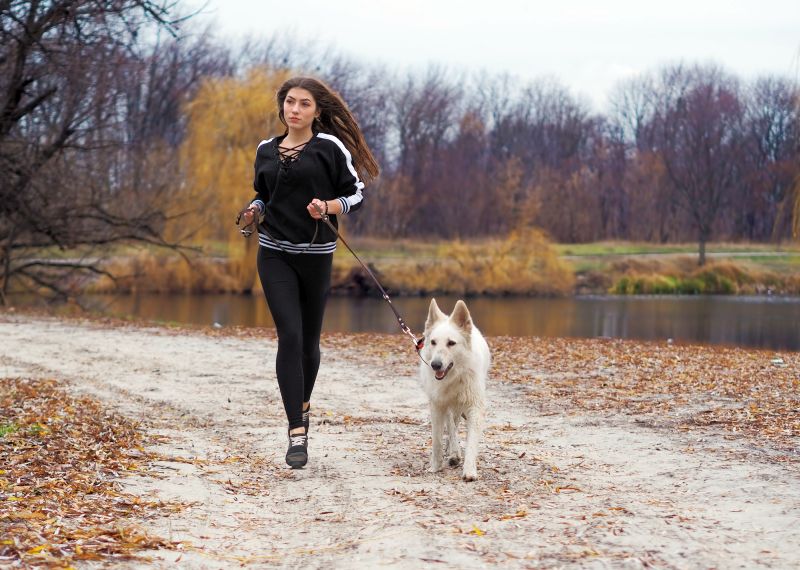
Almost all dogs like running in some fashion – but that doesn’t mean that all dogs make good running partners!
Some dogs are too small, too fluffy, too short-faced, too large, or too long-backed to be good running partners physically.
For example, I have a friend with an energetic Yorkshire terrier.
Little Max loves to run. But due to his purse-friendly size, he really can’t run very far and certainly wouldn’t be a good match for someone who wants to run 10ks with a canine.
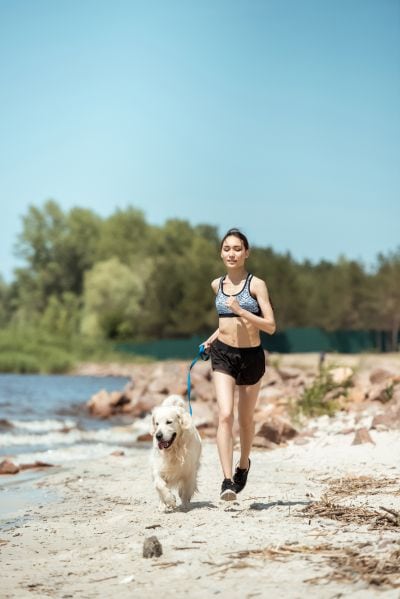
Other dogs have the leg length they need, but they have pacing or gait problems that make running alongside humans tricky.
Another friend of mine has a whippet named Pre (named after a famous runner), who exemplifies this.
Pre is an excellent runner, but his strides don’t match those of human joggers well.
He’s much better suited to sprinting around the yard or loping alongside a mountain bike, but he doesn’t trot alongside runners well. His pacing is just off, despite years of my friend’s efforts trying to work together!
Some dogs just aren’t that into running at all! Even if they have no physical limitations, they’d rather play tug or sit on the couch.
Other dogs might enjoy running in short spurts or running as a game, but they lack the focus to enjoy longer, more disciplined runs with you.
In contrast to all of these dogs who don’t make good running companions, I actually have two dogs who are both excellent running partners.
They both start to stretch and pace when I pull out my running shoes. Barley, my older dog, has run as much as 19 miles with me. Niffler, my younger dog, is a natural-born runner, who can reach impressive speeds. He has clocked in at 26 miles per hour during a skijoring training run.
My dogs don’t just love running; they’re excellent at it!
Consider a dog stroller! These nifty gadgets let you bring your barker out for a run and rest as needed, or simply sit back and enjoy the ride the entire time. Strollers are excellent for senior pups and small doggos, as they let your dog get in on the action without getting tuckered out.
Which Dog Breeds Make the Best Running Partners?
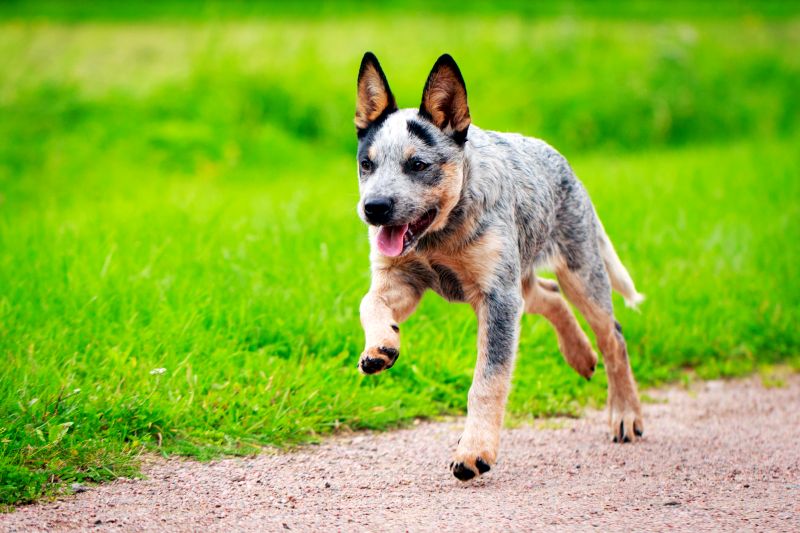
Generally, when looking for a canine running buddy, you’ll want to look for a medium-sized dog with an athletic build.
You’ll also want to try to avoid extreme face or body shapes, extreme coat types, and short legs.
Many dog breeds can make excellent running partners, but I’ll highlight a few of the list-toppers below.
- Border Collies: These dogs have energy for days, are medium-sized, easily trained, and come in a variety of coat types to fit your running climate. I love them so much that I’ve got two!
- Vizslas: Bred to run and run and run through the countryside in search of birds, Vizslas won’t disappoint on energy levels. They’re also a great size and have a light enough coat to tolerate running in many climates.
- Labrador Retrievers: Labs are popular for a reason. If you can get a lighter-boned lab and keep him trim, he will likely adore running ahead of you for miles!
- Australian Cattle Dogs (Red or Blue Heeler): These tough little dogs are absolute tanks that will run nonstop! Their coat is lighter than many border collies, but they’re smaller than Labs, making them perfect little running buddies.
- Various Pointers: If you are OK with a larger dog with a longer stride, pointers are incredible runners. They’re a bit larger than Vizslas and have the energy and enthusiasm to match!
You may be surprised to see Siberian huskies missing from this list. The problem is, they just overheat too easily – professional mushers typically avoid running their dogs when the temperature exceeds 50 degrees Fahrenheit.
So, I generally don’t recommend them except for owners living in pretty cool climates (and then, it is still advisable to restrict your running times to early morning or late evening).
Is Your Dog Healthy Enough to Run?
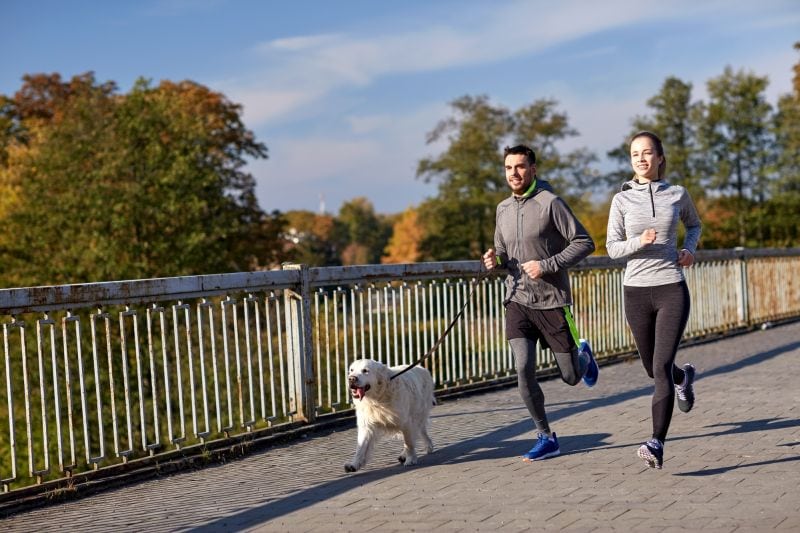
Dogs might not be healthy enough to run for a variety of reasons. And the definition of “healthy enough” varies.
Some dogs might be healthy enough for a few short jogs per month but not be cut out for marathon training, while other dogs might need a fitness plan or to grow up a bit before they run.
If you’re at all unsure if your dog is ready to run, be sure to chat with your vet and have a Certified Canine Fitness Trainer (CCFT) perform an assessment of your dog’s fitness and morphology.
In the meantime, here are some things to consider before starting to run with your dog:
- Age: Dogs shouldn’t go for long runs until their growth plates have closed. This is confirmed through X-ray but generally happens around 2 years of age (it happens earlier for small dogs and later for large dogs). The terrain matters too; off-leash runs in the woods can happen earlier than high-impact leashed runs on pavement. There’s not as clear of a cutoff for older dogs, but at some point, all dogs need to retire from hard exercise. My 9-year-old border collie still goes on most of my runs, but he stays home if I’m going more than seven miles.
- Hereditary Diseases: Dogs that suffer from cardiac issues, exercise-induced collapse (EIC), epilepsy, or a variety of other hereditary diseases probably shouldn’t go for runs. Check with your vet to ensure running would help more than harm before starting out.
- Morphology: We’ve mentioned before that dogs with extreme body shapes aren’t well-suited to running. While short-nosed dogs (like pugs and French bulldogs) and long-backed dogs (like corgis and dachshunds) might enjoy running, they simply aren’t built for long-term aerobic activity. Extra-large and extra-small dogs will also struggle. Talk with your vet and a CCFT to see if your dog may still benefit from short jogs, but your plan with these dogs will need to be much more careful than with moderately shaped dogs (like Labs and border collies).
- General Fitness: While running is a great way to get in shape, it’s also important not to push too far too fast. If your dog is currently a bit pudgy, start with short run-walks in your neighborhood and build up to longer runs. Check with your vet and a CCFT and consider some other ways to get your dog more exercise first.
- Injuries: Whether it’s a torn toenail or a ripped cruciate ligament, your pup needs to heal before a run. It took over 12 weeks after Barley’s TPLO surgery (for a torn cruciate ligament) for him to start going on short run-walks again with me. Regular smaller injuries like torn toenails or a cut paw pad can generally heal up within days, if you give your dog sufficient rest.
- Overall Gait and Conformation: A careful assessment of your dog’s posture and gait may reveal painful spots, muscular weakness, or injuries that a less in-depth exam would miss. This can require a professional eye to note things like a side-saddle sit, a roached back while standing, or just a slight swing in the hips while trotting. Sending video to a fitness specialist can ensure that you don’t miss something like possible hip dysplasia, a weak core, or wobbly knees that should be addressed before starting to run. Many dogs with pain hide it quite well – you rarely will see a limp or hear a whimper in most cases. Careful gait and posture assessments will tell you much more about his fitness and readiness for a workout routine!
Again, your precise running goals will influence what exactly disqualifies your dog from running. A 15-minute jog-walk is going to be acceptable for some dogs that simply can’t go for a two-hour run.
Equipment You Need to Run with Your Dog
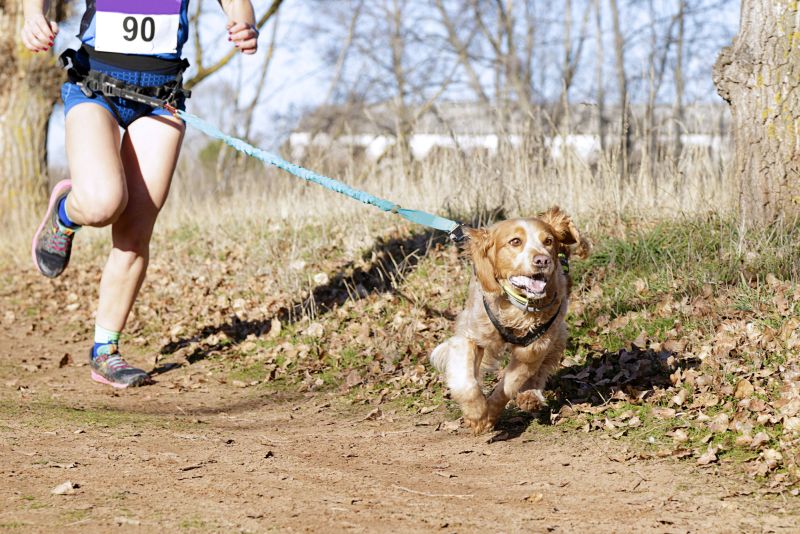
Before starting to run with your dog, it’s important to acquire the gear you’ll need and ensure that he’s comfortable with everything he’ll use.
You really only need two or three things for your doggo:
- Hands-Free Leash & Back-Clip Harness: If you want to embrace a minimalist mindset, all you need to run with your dog is a hands-free dog leash and a back-clip harness that’s good for running. I personally run with a Tanzilla Harness for sled dogs, the Ruffwear Omnijore, or the Ruffwear Flagline, paired with the Omnijore leash or a basic bungee waist leash.
- Water Bottle for Your Dog: If you’re going on longer runs, you may want to carry a water bottle for your dog (they may not be strictly necessary for short jogs around the block). Personally I’ve trained both of my dogs to drink out of a Camelbak hose, but that’s not for everyone (or every dog). This is especially important if you’re running in urban areas where clean drinking water is hard to find.
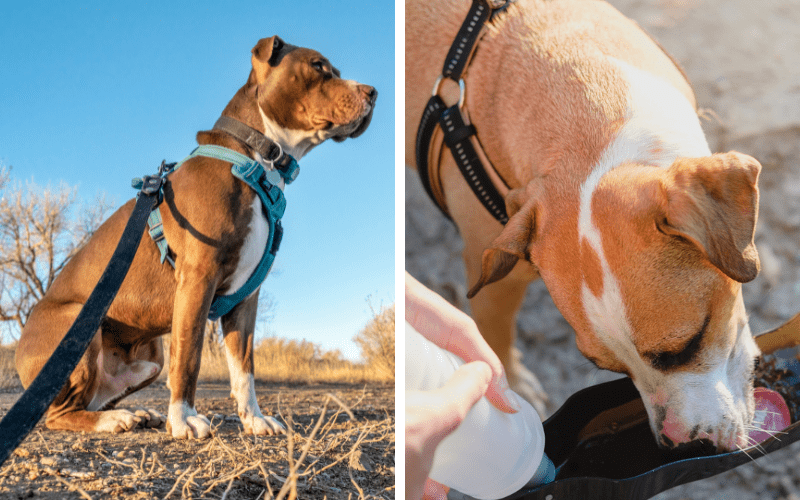
Some runners like to fit their dog with booties, but in my experience, most dogs are much happier not running in booties.
If the asphalt is too hot or the ground is too sharp, I generally leave my dogs at home. If my dogs have cuts on their paws, they also stay home. Most dog booties don’t have enough grip and aren’t quite comfortable for long runs.
That said, in the snow or ice you may want booties. Just use your judgment.
Of course, you may need a few things to enjoy running with your dog. Namely, you may want running shoes, shorts, and moisture-wicking tops. I also love having a place to stash keys, whether that’s a wrist holder or a small waist pack.
Otherwise, try to keep the gear to a minimum and have fun!
Ensure that everything fits without rubbing and that your pup is comfortable walking with the gear on before you start to introduce speed (and make sure your gear fits well too!). You don’t want your dog losing hair or suffering an injury because his gear doesn’t fit correctly.
Additionally, be sure to take the time to introduce your dog to his gear slowly if he’s not used to wearing a harness.
How to Train Your Dog to Run with You
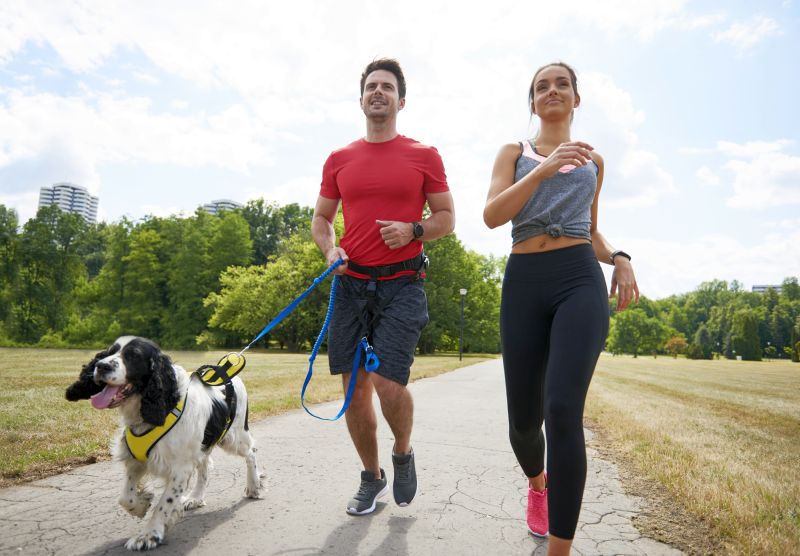
Now that you know some of the factors that’ll determine if your dog is a good candidate for life in the fast lane, we can talk about training your pooch to pick ‘em up and put ‘em down alongside you.
Start with Basic Manners
Before starting to run with your dog, it’s going to help to ensure that your dog knows some basic manners around the house and at lower speeds. It’s hard to train a dog while you’re running, so you’ll want to cover some basics before you hit the road (or trail).
For example, you’ll want to work on addressing any leash reactivity that your dog has to other dogs, people, cars, or bikes before starting to run. Your dog should also be comfortable with responding to his name and waiting at crosswalks.
Practice Leash Skills
While running, it’s important to have your dog consistently run in front of you or at your side.
I prefer to have my dogs run on a waist leash directly in front of me because this is easier on busy city paths and narrow mountain trails. My dogs are actually allowed to pull while on runs! This helps wear them out faster and makes my run a bit easier.
However, you may prefer to have your dog run at your side and not pull. Be sure this will work on the paths you choose; it can be hard to pass other runners and bikers may spook your dog if he’s at your side.
Decide on what works for you!
In almost all cases of running with your dog, you’ll want to teach a few new cues and skills to keep everyone safe and happy. You might not need all of the cues below, but these are what I use regularly with my dogs.
- Wait/Pause/Stop: I use the cue “hold up” to ask my dogs to stop. I taught them this by saying the phrase, then stopping my feet and using mild leash pressure. When your dog pauses, give him a little treat. Start practicing this skill while on your daily walks, pausing at each crosswalk. Your pup will pick it up quickly!
- Speed Up: Most dogs respond readily to repeated short notes, like “hup hup hup” or “go go go.” Simply say your chosen phrase and pick up the pace; most dogs will follow suit quickly!
- Slow Down: Dogs naturally respond to a long, low, descending word to slow down – imagine how cowboys say “woaaaah” to a spooked horse. Do the same as you slow down. You can readily teach this paired with speed up in a fun game of red light/green light!
- Right, Left, and Straight: If you think it’s “extra” to teach your dog directions, you might be right – you don’t have to teach your dog these cues. But they’re quite easy to teach and make your runs much more comfortable! Start teaching your dog these cues during walks. Just as you reach a corner on the sidewalk, say the direction you’re going and then head that direction. Professional mushers use the terms “gee” and “haw,” but I simply say right, left, and straight on to cue my dogs. Your dog will probably pick up on these words quickly.
- Pass Politely: Being pulled to the side whenever your dog wants to greet a person or sniff another dog is both annoying and potentially dangerous (not to mention on-leash dog greetings can be pretty stressful for many dogs)! Many people reuse known cues here to help their dogs learn to pass politely. For example, “leave it” and “speed up” can both work well in these situations. I taught my dogs “on by” as a cue to stay straight, focus forward, and keep moving. I taught this by throwing a toy or treat ahead of them on the walks and then saying “on by” as we move towards it. Over time, I added distractions that my dogs had to ignore while chasing down the tossed toy or ball. Finally, I started to fade out the tossed temptation, and I don’t use it anymore now.
Start Introducing Speed
Now that your dog knows how to wear his running gear and follow directions, it’s time to go for a run!
Depending on your team’s fitness level and baseline, your first run might just be 2 to 3 minutes at the end of your daily walk. Or, if your dog is already in good shape, you may run for quite a bit more time or distance.
Just ensure that you stop if your dog seems tired and keep practicing the cues he needs to be a great running partner! You can fade out treats later, but don’t start to back off the treats until you consistently like his behavior.
You can also help your dog speed up and focus forward by “chasing” another runner. This method works wonders!
If your dog handles running well and you’re really loving the speed, you may want to consider canicross with your pup.
Increase Distance
Whether your baseline was 3 minutes or 30, you’ll likely want to start increasing the difficulty of your runs as you progress.
Just be sure to increase your distance slowly, over time before you jump fully into long-distance running with your dog. Ensure you’re keeping a close eye on your pup’s comfort, fitness, and enthusiasm.
In many cases, humans struggle more with running than our pups.
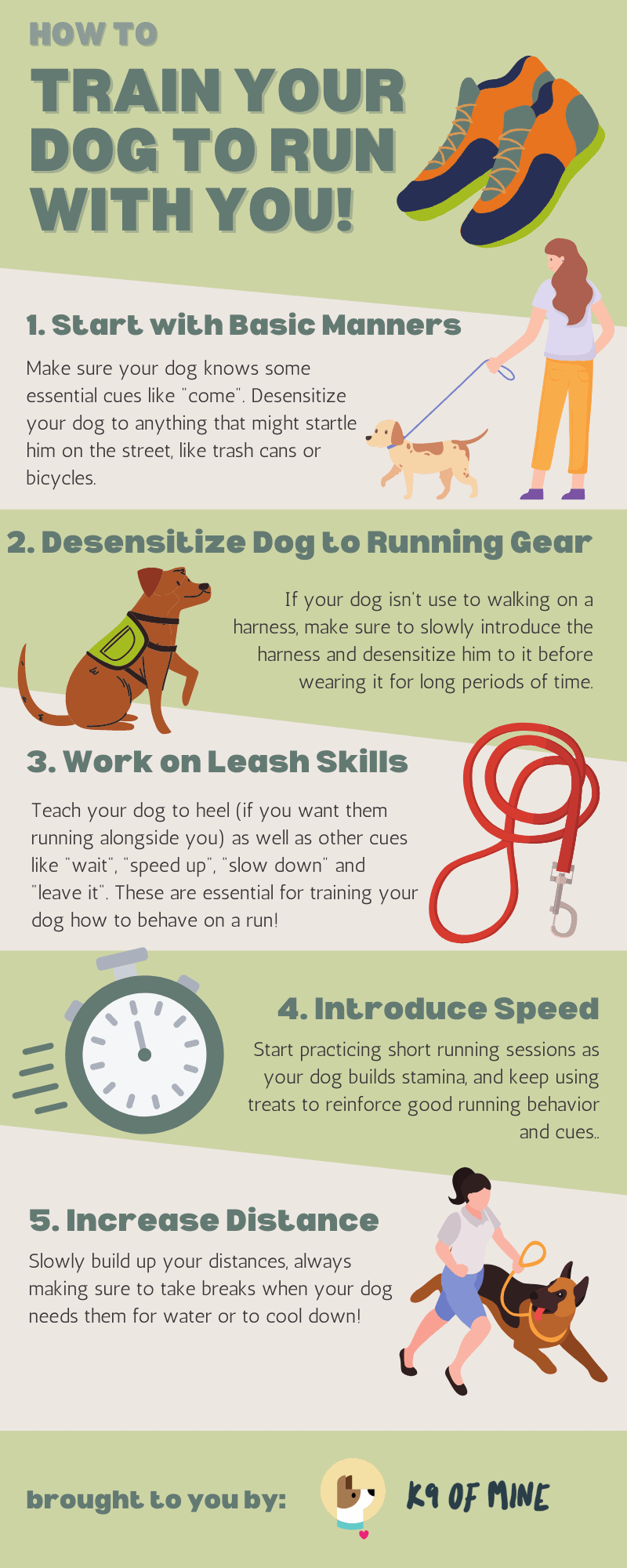
Running with Your Dog: Common Problems & Solutions
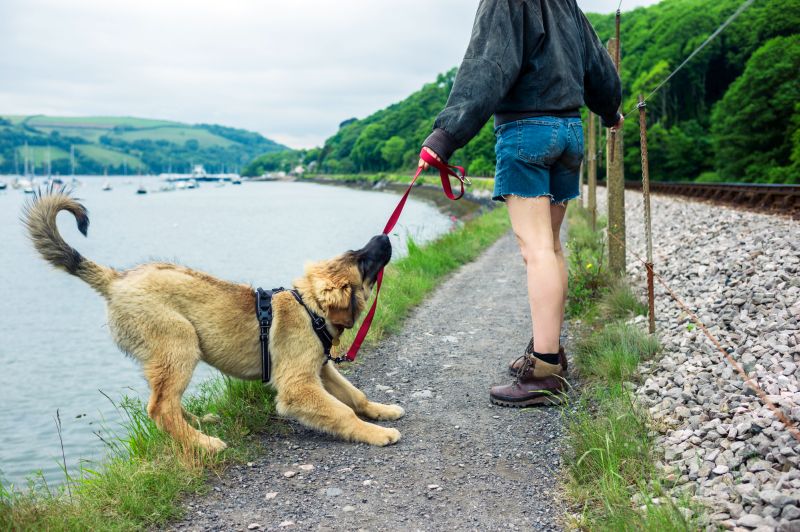
Running with your dog is a pretty straightforward activity, but many owners run into problems at one point or another. We’ll try to address a few of the most common challenges owners face and share some solutions below.
My dog stops and sniffs EVERYTHING!
Start out your runs with a good sniffy walk to see if your dog just needs to “check the pee-mail” before getting down to his workout – this can help him remain focused once you start running.
Sometimes sniffing functions as a stress-relieving “Facebook check,” so your dog might actually be sniffing as a way to get a break from running. In these cases, it’s probably best to just let him sniff for a moment and then get back to it.
Also, consider whether your pup actually wants to run. If he seems like he’s constantly stopping to sniff, he may just not be a good running companion.
My dog won’t run at my side.
As I said above, I actually prefer having my dog in front of me for a variety of reasons. Consider what your goals are and whether it’s actually necessary to have your dog at your side or not!
However, if you do want your dog at your side, start by teaching him to stick by your side while walking. Once he can do this, you can start introducing speed to the equation!
My dog gets too tired too quickly.
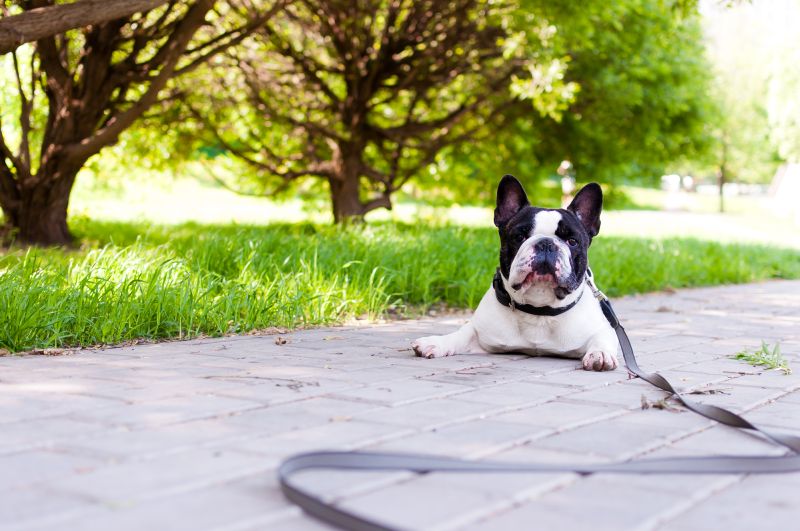
Dogs need to build up endurance and stamina, just like you. Even though you’re running together, your pup might need more training to keep up!
This will depend a lot on your dog’s physical baseline and varies a lot – imagine different runners on the same high school running team. Despite training together, they won’t always be the same speed!
Work on a little training plan to help your dog build up to the distance and speed you’d like to hit. Chat with a CCFT to see if your dog needs extra strength or conditioning to meet your running goals.
My dog pulls me while running.
If your dog starts to pull too hard, slow down and cue him to do the same. Basically, teach your dog that pulling too hard actually makes you slow down.
Be consistent about this! It can be frustrating to teach this lesson during a “real” run, so consider doing this separately from your marathon training runs.
My dog jumps on me or nips at my heels.
Sometimes dogs get so excited to run that they start to nip and jump. Try playing arousal layering games and pattern games to help your dog calm down before or during runs.
I also used a somewhat forceful “no” with Niffler three to four times when he first started running with me, and the problem never came back. He simply needed communication that jumping at me wasn’t OK!
My dog lunges at people/dogs/cars when running.
There are a number of ways to address and train a reactive dog, including desensitization and counterconditioning, among others. But you’ll have to address reactivity issues while standing still and walking first – then you can apply them to running.
Generally, if you’ve properly addressed reactivity at other speeds, your dog should improve while running.
Also, be sure to practice your “on by” cue at speeds if your dog just likes to dart over while running.
My dog gets tangled around everything.
Go back to the basics of leash skills. Part of why I like having my dogs in front and teaching them directionals is that I can more easily reduce tangles.
Help your dog learn to focus forward by chasing another runner if he’s just all over the place.
Canine Running Safety

Running with your best friend requires a bit of extra preparation and consideration to stay safe. Your dog has some needs that you need to be aware of to ensure he’s happy. On any run, be sure to consider:
- Water: Just like you, your dog needs extra water while exercising. Ensure you offer adequate water before and after short runs, and during longer runs.
- Mealtimes: Dogs shouldn’t run directly after a meal and shouldn’t eat while they’re still panting or hot from their run. I generally feed my dogs at least two hours before a run or one hour after.
- Visibility: If you’re running at dawn or dusk, you’ll want to ensure that your dog is highly visible. Most harnesses have reflective strips, but I use a light-up LED dog collar as well to ensure my buddies stay safe on our runs.
- Temperature: Dogs can’t regulate their body temperature as well as humans while they’re running. They only cool off by panting and by sweating through their paws, meaning heat and humidity hit them harder! Your dog’s heat tolerance will vary based on fitness, acclimation, morphology, and coat type.
- On-Leash or Off-Leash? If you’re running in urban areas or areas with leash requirements, this is a no-brainer – your dog oughta be leashed. However, trails that allow off-leash running can be a great place to really let your dogs run. Personally, most of my runs are off-leash in off-leash legal areas. This requires quite a bit of training for off-leash reliability, but it allows my dogs and I to both enjoy nature fully at our own pace.
- Foot Protection: As I mentioned above, generally I skip the run if I think foot protection is needed for my dogs. The exception is snow or ice, where I’ll spring for lightweight mushing booties.
- Warm-Up and Cool-Down: Start your runs with a brisk walk and some stretching for your pup. I use a treat to lure my dogs through some circle bends (nose to tail), downward dog, and stretching forward for a treat. We repeat the same exercise at the end, plus some massaging and careful monitoring for soreness.
- Appropriate Training Loads: Overtraining or inconsistent training is a recipe for soreness and injury for dogs. Ensure you’re checking in with your dog’s enthusiasm, posture, gait, and flexibility to monitor for any issues he’s having with training. Dogs need rest days and easy weeks just like we do!
- Other Dogs: Unfortunately, not all dogs are appropriately restrained or safe to interact with. I always carry PetSafe Citronella Spray Shield while running and practice using it. With a range of about10 feet, I can directly aim harmless (but gross for dogs) citronella spray at a charging dog. To be honest, I use this quite liberally to prevent fights and help my dogs feel confident that I’ve got their backs.
Canine Treadmills: A Viable Alternative
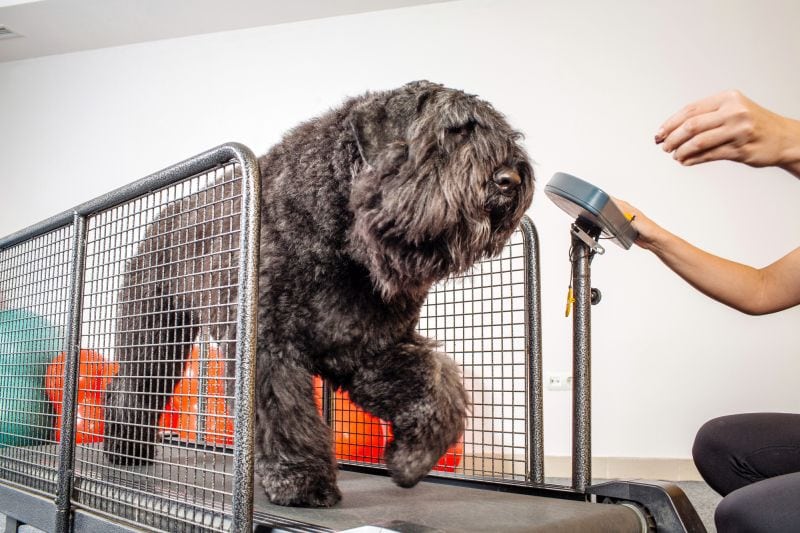
For a variety of health, scheduling, or interest reasons, you might not be able to run with a dog that desperately wants to run.
In the long term, a canine treadmill might save you money compared to hiring someone else to run with your dog. Some dogs may also struggle with reactivity to other dogs, or your area might be too hot or crowded to reasonably run with a dog.
Regardless of the reason running doesn’t work for you or your dog, you might want to check out a canine treadmill.
Treadmills take some careful introduction, but many dogs will love the opportunity to run to their heart’s content! Ensure you have enough space to store one – they’re quite a bit longer than human treadmills!
Training Your Dog to Run: FAQ

Still have lingering questions about teaching your dog to run? Don’t worry – we’ve got you covered! We’ve rounded up some of the most common questions below!
How far can dogs run?
Most “average” dogs will happily run 5 to 10 miles. However, highly trained athletes often run much, much farther than that.
My dog Barley has run 19 miles before, but that barely holds a candle to long-distance mushing dogs that run (in teams) for hundreds of miles over the course of multi-day races.
How do I train my dog to run with me?
Start with introducing your dog to the manners, cues, and equipment he’ll need on a run. Ensure he’s comfortable on-leash in the environment you’ll be running in and that he can respond to basic cues regarding speed and direction.
Start slow and easy with your runs, building up stamina and speed for your pup.
At what age can my dog start running with me?
Generally it’s best to wait until dogs are at least 2 years old before starting a training regimen. This is based on when their growth plates close, which can be confirmed via X-ray. Larger dogs’ growth plates close later in life than smaller dogs.
Is it good for dogs to run with you?
Many dogs enjoy running and receive the same fitness benefits from running that you get!
However, it’s important to confirm with your vet that your dog is ready to run based on fitness, morphology, and coat type. Not all dogs are well-suited to long runs, and some dogs should stay in-shape with other exercises altogether.
Are there events you can run with your dog?
Yes! Canicross races are races for one-person-and-one-dog teams. They’re usually between 1 kilometer and 5 kilometers. You can also check RunSignUp.com for dog-friendly races nearby or keep an eye out for dog-friendly charity runs for your local animal shelter.
Running with your dog can be a great way to bond, both get in shape, and see the world. I hope that you and your dog can get outside and enjoy nature together through a leisurely jog or a tempo run together.
Let us know in the comments below how it goes and if you have any questions!
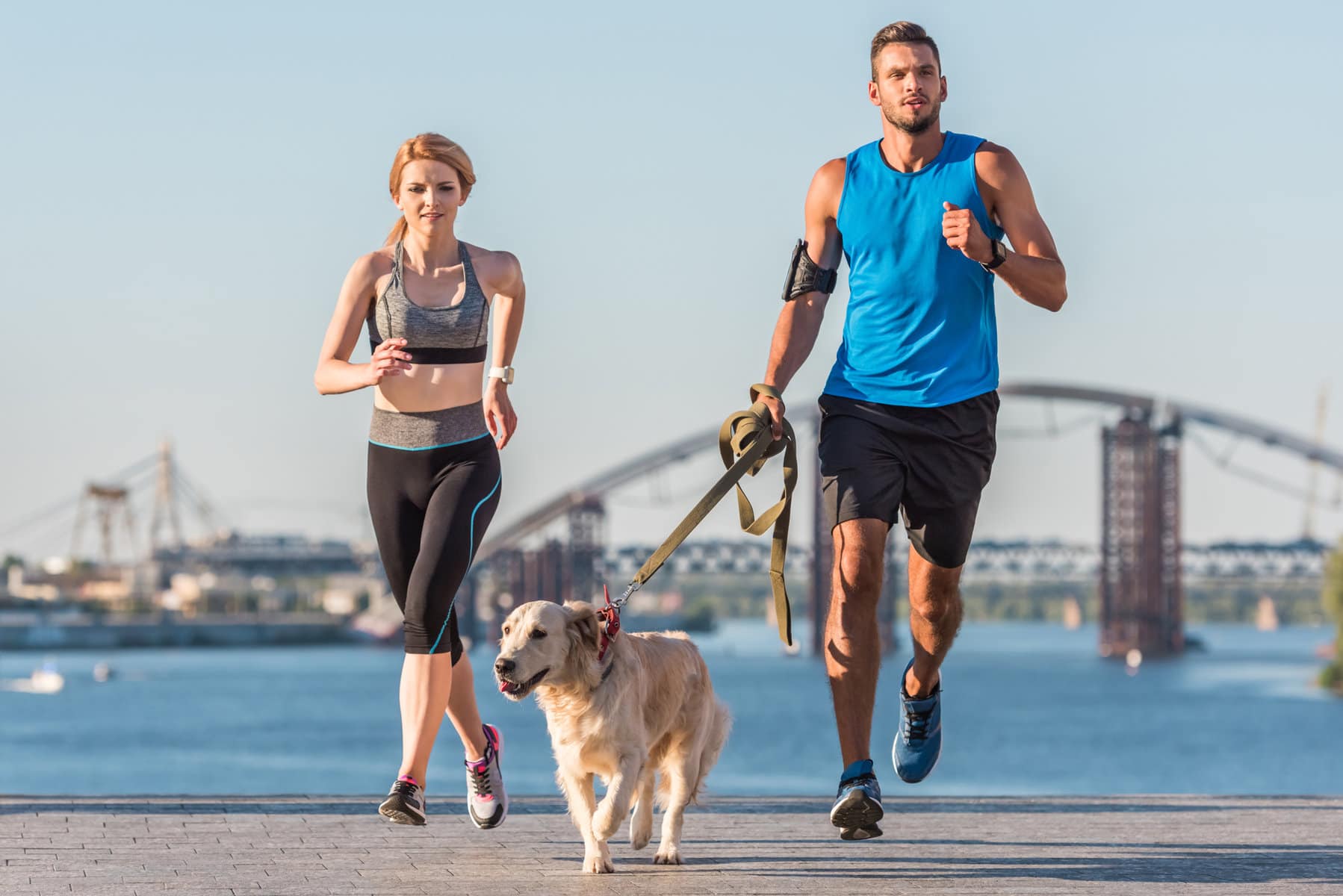

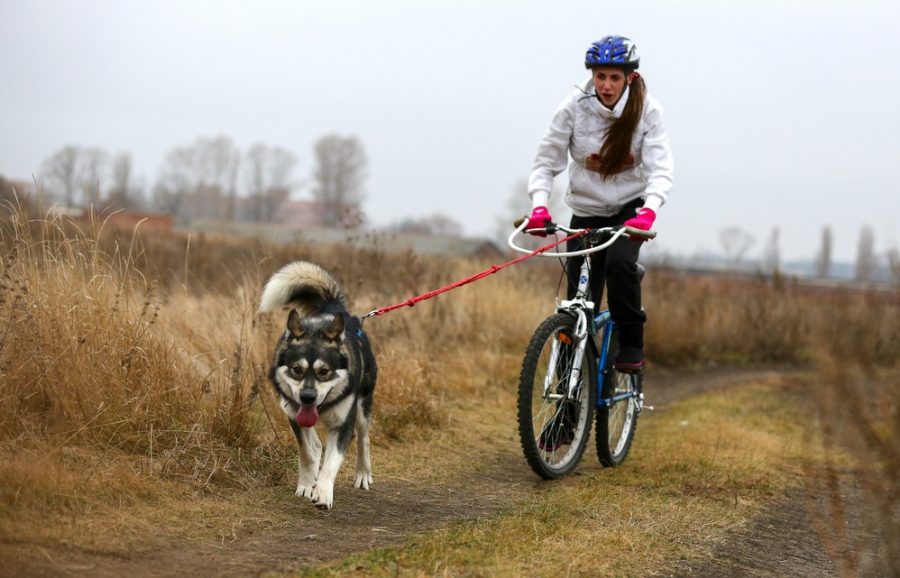


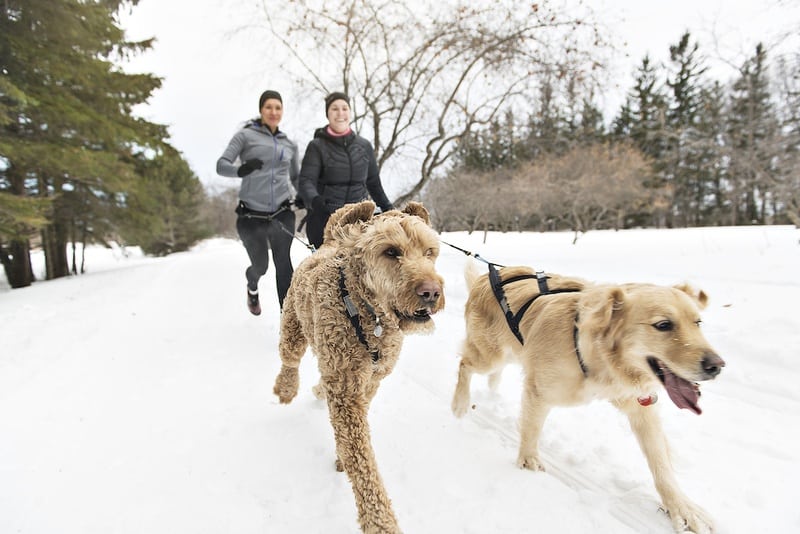
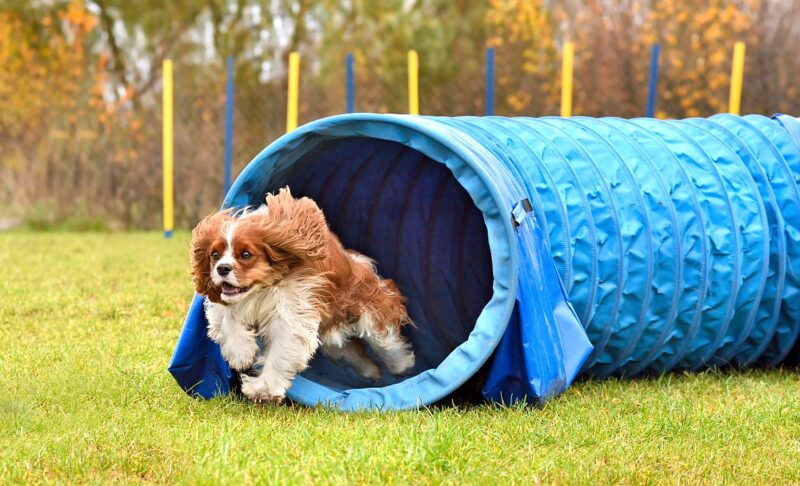
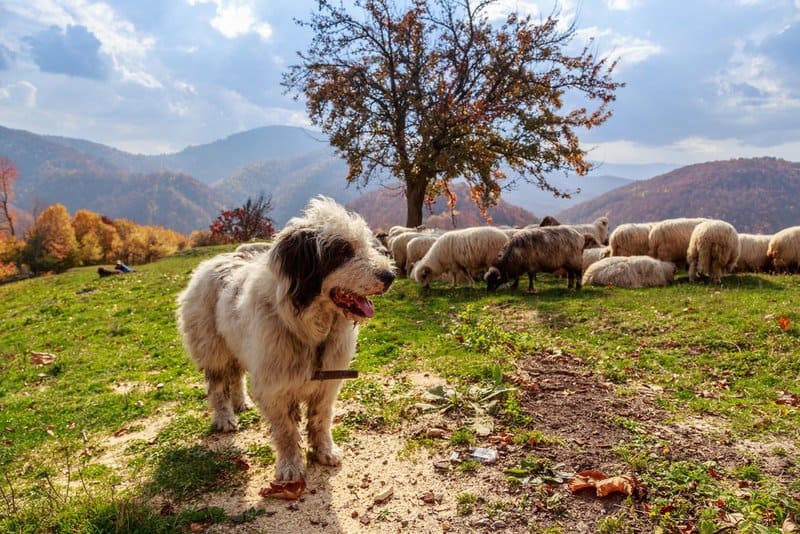
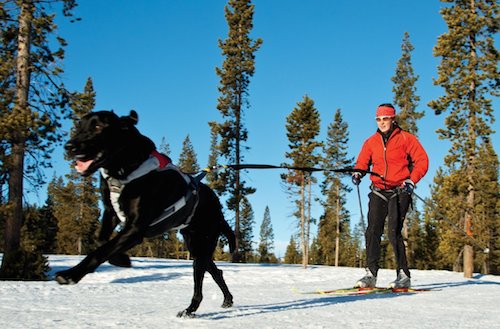
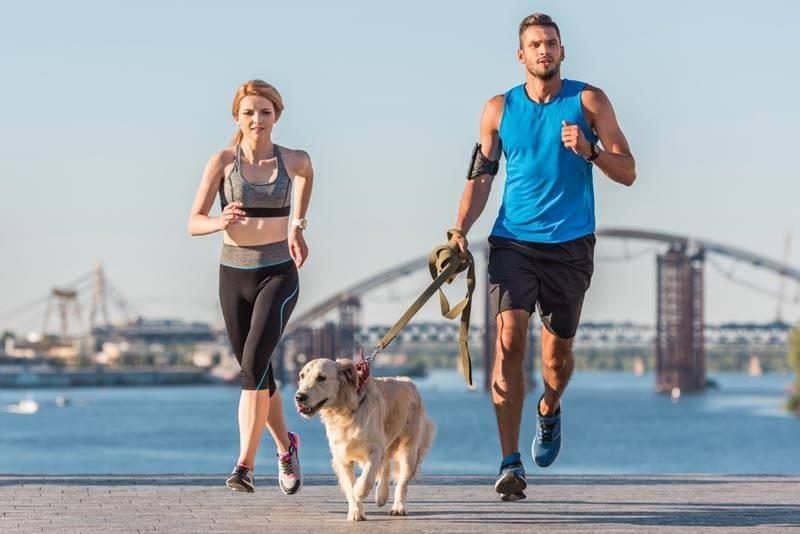

Leave a Comment